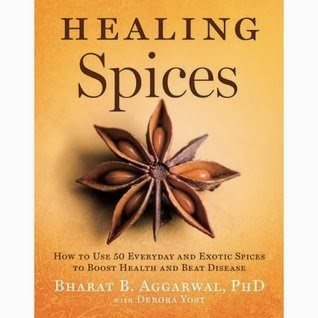Our kitchens are full of medicines. The herb and spice rack isn’t the first place most people look for remedies to sooth stomachaches or other minor discomforts, but it’s a good place to start.
The earliest healers used local plants to treat illness and maintain good health. Eventually these plants became cultivated for regular consumption and found their way into everyday foods. Now regarded simply as seasoning, the medicinal uses of culinary herbs and spices have been largely forgotten.
Fortunately, Bharat B. Aggarwal's new book,
Healing Spices: How to Use 50 Everyday and Exotic Spices To Boost Health and Beat Disease, helps us remember.
This tome is a superb reference for all the herbs and spices that most will ever need. Aggarwal (with Debora Yost) discusses where they come from, how they can be used medicinally, how to select and store them, and how to cook with them.
Recipes are sprinkled throughout the book (I'm looking forward to making
Coconut Meatballls with Peanut Sauce on page 101) and Part Three is dedicated to spice blends. Learn how to cook with flavors from France, China, North Africa, Latin America and the Middle East. Discover how easy it is to make your own
adobo without MSG and what differentiates a Thai curry from a Indian or Caribbean curry.
I received this book as an unexpected gift, but it's quickly become an indispensable part of my kitchen.
Healing Spices is a must-have for cooks, foodies and health enthusiasts alike.
In New York City, hard-to-find spices are often found at
Kalustyan's on Lexington Avenue between 28th and 29th Streets. While you're there, don't miss the
urfa biber or freshly dried curry leaves.






